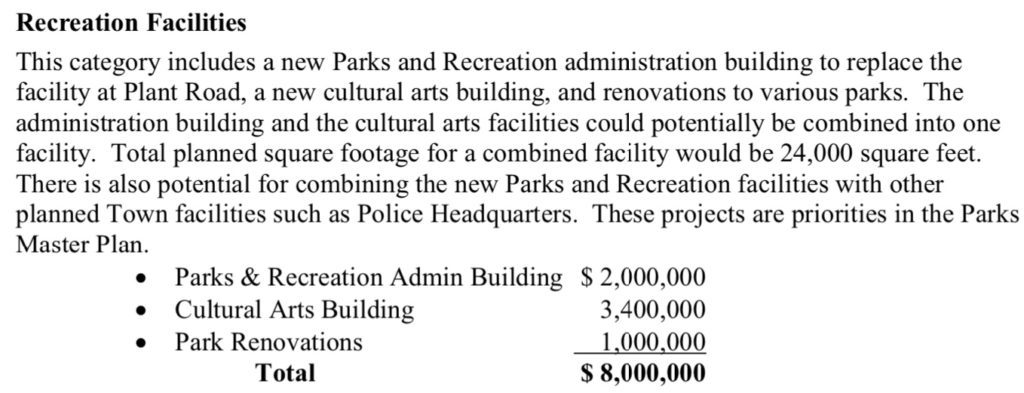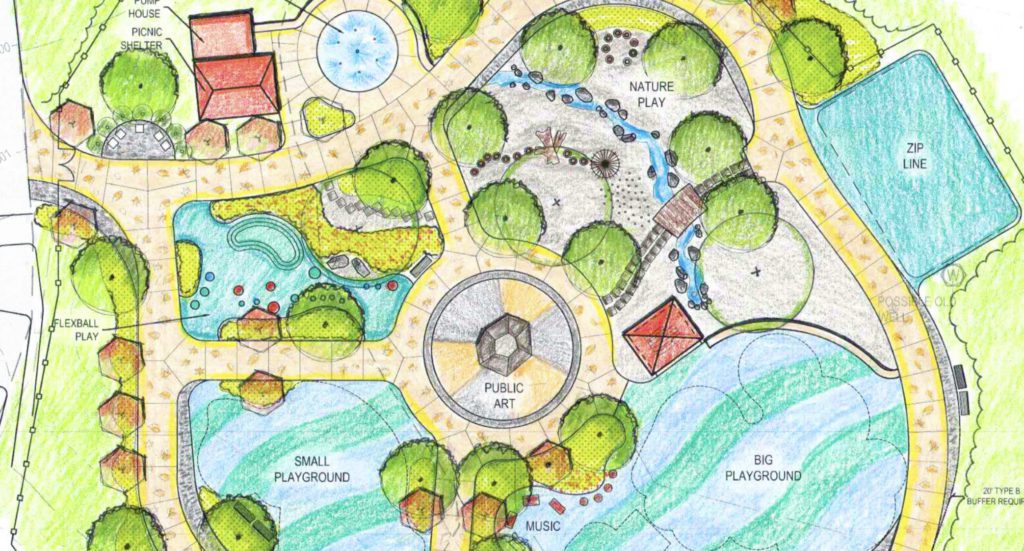
The nice thing about signing a petition is it allows you to feel virtuous without the need to contemplate any hard choices or competing priorities. And what’s more virtuous than advocating for a community good when you don’t have to figure out how to pay for it?
That’s no doubt the reason behind the relative popularity of the various petitions demanding that the 36.2-acre former home of the American Legion Post 6, now owned by the Town of Chapel Hill, be turned entirely into a community park. Who could be opposed to a big new park in Chapel Hill?
There’s a big difference between dreams and reality. Petitions are dreams, and there is simply no realistic path forward towards constructing a park on the entire American Legion site. As we have documented previously, and as Town staff describes in this week’s meeting agenda materials, there’s no way to pay for a park. The Town has much higher priorities than building a new, large, from-the-ground up park. No money means no park. And that’s why nothing has happened in the almost six years since the Town hurriedly purchased the land to block potential residential development.
Now, five Town Council members have filed a council petition to shake up the status quo. For the first time, this petition establishes a process towards development of an actual park. It make something out of an underused piece of land that now benefits few residents and costs the Town hundreds of thousands of dollars to maintain it. The council petition proposes to sell off pieces of the land for private development that addresses other Town priorities. That distresses the petition-signers, who want a park on the site and nothing else. But developing a park costs money, and selling a portion of the land can fund that work without shortchanging other Town priorities.
Given the history of how and why the Town acquired the American Legion site, it is particularly sensible to sell a piece of the land to fund the development of a park on the rest of the land. To understand why the Town lacks the resources to develop the entire American Legion site as a park, it’s helpful to look at the manner in which the site was purchased, and the Town’s other parks and recreation priorities.
Purchase of the Park
Leading up to the 2015 elections, the Town placed on the ballot a series of bond referenda which were designed to invest in Town priorities. One of the proposed bonds related to parks and recreation, and when the Town Council voted to place the parks bond referendum on the ballot this was the list of projects envisioned:

The parks bond was approved in November 2015. This vote took place during the same election when a CHALT-backed slate of candidates defeated incumbent Mayor Mark Kleinschmidt due to anger over new development in the town, particularly the Berkshire apartment building next to Whole Foods.
Fast-forward to late 2016, when the new CHALT-backed Council was faced with a proposal to build housing on the site of American Legion Post 6. While the developer proposed a higher-density development that would have required a council-approved rezoning, the developers could have built more than 100 single-family homes without council action. Correspondence sent to Town Council showed that although most residents opposed building more “luxury” apartments, there was general agreement that it would be appropriate to place on the site other types of development such as affordable housing or office/retail uses. In the wake of this public outcry, Town Council agreed to pay $7.9 million to purchase the property. At the time, the Town had $3.6 million in excess fund balance which could have been used on a number of other Town priorities. Instead, those funds were directed towards making the first of three installments on the property. The Town still had to figure out how to pay the remaining $4.3 million.
When the bill came due, the only source of readily available funds was the 2015 parks bond. Never mind that the plan for parks bond spending had been based on priorities identified in the Town’s 2013 Comprehensive Parks Plan, and prioritized administrative space and a cultural arts center far ahead of land-banking for a future park. The Town had a debt to pay, and so much-needed space for parks & recreation staff and a building for cultural arts use were sacrificed to pay for land-banking of the American Legion site.
I would add (as someone who was on the P&R Commission in the 2010s) that the use of 2015 park bonds to purchase the property has delayed much needed park improvements in order to focus solely on land banking for a property the Town doesn't have $ to develop.
— Erin Crouse (@erincrouse) May 28, 2022
Parks and Recreation Priorities
Proponents of preserving the American Legion site as 100% open space seem to think that the town’s intention to use part of the land to meet other town priorities is just a giveaway to developers. However, none of these proponents have identified a path forward towards even beginning to pay for development of a park, and they ignore all the town’s other priorities, including other parks and recreation plans. (Not to mention that the Town Council never intended to use the entire site as a park, but that’s another story.)
What about American Rescue Plan Act (ARPA) funds? Following extensive discussion about town needs with staff and with council, the Town has developed a tentative plan which allocates 25% of the $10 million in ARPA funding towards parks and recreation uses. Development of a park on the Legion site does not make the potential list of projects. Council and staff have identified four projects as priorities for the funding—replacement of the heavily-used and rapidly deteriorating artificial turf at Cedar Falls Park ($1.15 million); development of a splash pad (something that many area families have requested, for $1 million); repair to the Town’s deteriorating skate park ($1 million), and the long-delayed construction of an adaptive playground that opens up a day at the playground to children of all abilities ($1.5 million). These high priority projects already exceed the $2.5 million ARPA funds proposed for parks and recreation projects. A petition’s priorities for facilities on the American Legion site, with its unrealistic cost estimates, are far down on the list.

How about other sources? The Town’s proposed Capital Investment Program through Fiscal Year 2033 does not include funds to develop a park on the American Legion site. It includes numerous priorities for extension and refurbishment of existing park facilities, but development of the American Legion site isn’t on the list. Contrary to American Legion site maximalists’ complaints about the lack of open space and park facilities in Town, the Town has many existing facilities which need to be kept safe and open for use by Town residents and visitors.
The Town’s park and recreation staff are making a presentation to Council on Wednesday, and they have identified a long list of high-priority repair projects. It would be dangerous and frankly disrespectful to Chapel Hill residents to postpone these much-needed investments to move forward on a park at the Legion site. The Parks, Greenways, and Recreation Commission’s own list of project priorities includes the Cedar Falls Park turf replacement, the adaptive playground project, reconstruction of tennis courts at Ephesus Park (which is next to the Legion site); repair of the Hargraves Park pool, and installing LED lights at parks throughout the town, among other projects.
The funds simply don’t exist to build a park on the American Legion site.
The Choices
It’s been close to six years since the Town bought the American Legion site for $7.9 million (more if you consider interest costs for the bonds used to pay more than half the cost). Since that time, little has happened. Some volunteers have cleared weeds from site site, and neighbors walk along the open space, but the site is not open and welcoming to Town residents. The status quo is and will continue to be exclusionary. That’s not for a lack of effort by Town staff—rather, it’s because the rash decision to purchase the land was not accompanied by a plan to actually build a park.
There are two paths forward. The first is continuing the status quo. The Town bought the American Legion site in response to local outcry in 2016 over a proposal to build homes on the site. The Town made this purchase even though it had not set aside funds for the purchase, and that decision has delayed other high-priority parks investments that the town was planning to make. Six years later, there remain other high-priority parks investments, there is still no money to build a park on the site, and there’s no realistic path towards building one. Everyone promoting or signing onto a petition to reserve the entire American Legion site for a park should recognize that each signature is a call to extend the status quo of no park and no plan for a park.
The second option establishes a realistic path towards development of a world-class community park. The petition by Mayor Pro Tem Stegman and council members Berry, Huynh, Miller-Foushee, and Parker calls for the Town to investigate the sale of part of the site to meet key town priorities such as missing middle housing or retail/office space, and to use the revenue from that sale and the properties’ ongoing tax property payments towards constructing a large actual American Legion Park that meets the community’s needs. This is consistent with the Town’s intention when it purchased the land in 2016. Will the numbers work out and will there be revenue to pay for the new park? Town staff need to do the work to find out. It’s been six years, and now that there’s a plan, it’s time to move forward with developing the American Legion site.
